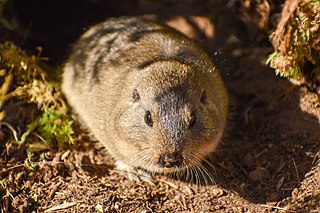
A tuco-tuco is a neotropical rodent in the family Ctenomyidae. Tuco-tucos belong to the only living genus of the family Ctenomyidae, Ctenomys, but they include approximately 60 different species. The common name, "tuco-tuco", comes from the "tuc-tuc" sound they make while they dig their burrows.

The Brazilian tuco-tuco is a tuco-tuco species. It is found mainly in the state of Minas Gerais in southeastern Brazil, though Charles Darwin mentions it during his trip through present-day Uruguay.

The collared tuco-tuco is a tuco-tuco species from South America. It is found in southern Brazil, Uruguay and northern Argentina where it lives underground in a burrow it digs in savannah habitats. It is a relatively common species and the IUCN has assessed its conservation status as being of "least concern".
The Argentine tuco-tuco is a species of rodent in the family Ctenomyidae. It is endemic to Argentina.

The southern tuco-tuco is a species of rodent in the family Ctenomyidae. It is endemic to Argentina.
The tawny tuco-tuco is a species of burrowing rodent in the family Ctenomyidae. It is found in the desert regions of northern Chile and adjoining areas of Argentina.
The Maule tuco-tuco is a species of rodent in the family Ctenomyidae. It is found in Argentina and Chile, where it occupies several different types of habitats. It is a common species, and the IUCN has assessed its conservation status as being of "least concern". The common and scientific names refer to a river and region in Chile within its range.
The Mendoza tuco-tuco is a species of rodent in the family Ctenomyidae.
The Goya tuco-tuco is a species of rodent in the family Ctenomyidae. It is endemic to Argentina.
The San Luis tuco-tuco is a species of rodent in the family Ctenomyidae. It is endemic to Argentina.
The Salta tuco-tuco is a species of rodent in the family Ctenomyidae. It is endemic to Argentina and Bolivia.

The silky tuco-tuco is a species of rodent in the family Ctenomyidae. It is endemic to Argentina.

The Talas tuco-tuco is a species of tuco-tuco endemic to eastern Argentina.

The robust tuco-tuco is a species of rodent in the family Ctenomyidae. It is a burrowing rodent and is endemic to the Tucumán Province of Argentina.
Berg's tuco-tuco is a species of rodent in the family Ctenomyidae, named after the Latvian-Argentine biologist Frederico Guillermo Carlos Berg. It is endemic to northwestern Córdoba Province in central Argentina. Its habitat is grassy areas overlying sand dunes. The species is threatened by the degradation and severe fragmentation of its small habitat.
Budin's tuco-tuco was formerly considered a species of rodent in the family Ctenomyidae. It is endemic to southeast Jujuy Province in northwest Argentina. Given the extensive human presence in its limited range, it has been suspected to be threatened. The IUCN currently views it as a subspecies of C. frater. It was named after Emilio Budin, an Argentine specimen collector who worked with Oldfield Thomas.
The Puntilla tuco-tuco is a species of rodent in the family Ctenomyidae. It is endemic to central Argentina. The common name of the species comes from the municipality of La Puntilla at the type locality. It was first described by the British zoologist Oldfield Thomas in 1920 after being collected by Emilio Budin, an Argentine specimen collector who worked with Oldfield Thomas.
Foch's tuco-tuco is a species of rodent in the family Ctenomyidae. It is endemic to northwestern Argentina, where it is known from southwestern Catamarca Province. The species is named after World War I general Ferdinand Foch.
Scaglia's tuco-tuco is a species of rodent in the family Ctenomyidae. It is endemic to a locality in Tucumán Province, northern Argentina. The species is named after Argentine naturalist Galileo Juan Scaglia (1915–1989). Its karyotype has 2n = 36 and FN = 64.








